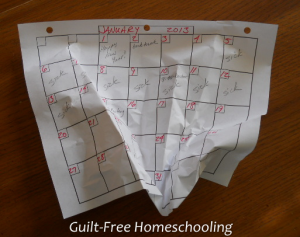 Summer doesn’t have to be either a full-on homeschooling schedule or a completely idle break. Summer is a great time for Mom to do a little planning ahead for the coming school year and think about what could be tweaked to make homeschooling more interesting, more efficient, and generally better for all concerned.
Summer doesn’t have to be either a full-on homeschooling schedule or a completely idle break. Summer is a great time for Mom to do a little planning ahead for the coming school year and think about what could be tweaked to make homeschooling more interesting, more efficient, and generally better for all concerned.
Kids who need some extra time to finish out their year can work through summer while still having a break by doing only half a lesson each day. Reading and math can be practiced without being tedious: read fun stuff; play games that use money or that require score-keeping (let each player keep his own score) or that have questions to be read aloud.
Summer is also useful for the student who wants to get ahead, not just for those who are trying to catch up. When my daughter was nearing her senior year of Homeschool High, she was planning to take a class at the Community College in the Fall to supplement her homeschool classes. Not knowing how much work that course would require, she spent the summer getting other classes out of the way. She read through an entire history textbook (a big, fat one), just so she wouldn’t have to deal with that class during the coming year while doing homeschool and college at the same time.
Maybe you’d like to try adding a few more supplemental activities. Maybe you’ve been intrigued by some unschooling ideas. Maybe your kids need a break from the formal curriculum. Maybe you’d like to indulge in an activity during the summer break that deserves more time than you could spare during your regular schedule. Maybe you’ve been thinking about a specific field trip that would work better in summer weather than from Fall through Spring. Maybe you or your students have a special interest that could be explored for a day or a week during summer break.
Explore some new ideas in the articles below and brainstorm the what-if’s of how your homeschool schedule might be different. Whatever your interests, remember that summer is an opportunity for learning, not a reason to stress yourselves out by doing too much.
The Value of Supplemental Activities
The Importance of Play in Education
“Stealth Learning” Through Free Play
How to Adapt Lessons to Fit Your Student’s Interests and Make Learning Come Alive
10 Ways to Improve a Lesson
A Day Without Lessons
Homeschooling the Neighborhood
Read the entire GFHS Summer Camp series:
Homeschool Mommy Summer Camp
Homeschool Summer Camp FUN!
Homeschool Summer Reading Activities
Homeschool Summer Scheduling
Encouragement Around the Campfire





 Guilt-Free Homeschooling is the creation of Carolyn Morrison and her daughter, Jennifer Leonhard. After serious disappointments with public school, Carolyn spent the next 11 years homeschooling her two children, from elementary to high school graduation and college admission. Refusing to force new homeschooling families to re-invent the wheel, Carolyn and Jennifer now share their encouragement, support, tips, and tricks, filling their blog with "all the answers we were looking for as a new-to-homeschooling family" and making this website a valuable resource for parents, not just a daily journal. Guilt-Free Homeschooling -- Equipping Parents for Homeschooling Success!
Guilt-Free Homeschooling is the creation of Carolyn Morrison and her daughter, Jennifer Leonhard. After serious disappointments with public school, Carolyn spent the next 11 years homeschooling her two children, from elementary to high school graduation and college admission. Refusing to force new homeschooling families to re-invent the wheel, Carolyn and Jennifer now share their encouragement, support, tips, and tricks, filling their blog with "all the answers we were looking for as a new-to-homeschooling family" and making this website a valuable resource for parents, not just a daily journal. Guilt-Free Homeschooling -- Equipping Parents for Homeschooling Success!

Recent Comments